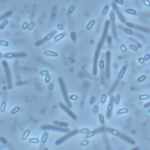Link to Pubmed [PMID] – 8955391
J. Bacteriol. 1996 Dec;178(24):7112-9
Bacteriophage lambda adsorbs to its Escherichia coli K-12 host by interacting with LamB, a maltose- and maltodextrin-specific porin of the outer membrane. LamB also serves as a receptor for several other bacteriophages. Lambda DNA requires, in addition to LamB, the presence of two bacterial cytoplasmic integral membrane proteins for penetration, namely, the IIC(Man) and IID(Man) proteins of the E. coli mannose transporter, a member of the sugar-specific phosphoenolpyruvate:sugar phosphotransferase system (PTS). The PTS transporters for mannose of E. coli, for fructose of Bacillus subtilis, and for sorbose of Klebsiella pneumoniae were shown to be highly similar to each other but significantly different from other PTS transporters. These three enzyme II complexes are the only ones to possess distinct IIC and IID transmembrane proteins. In the present work, we show that the fructose-specific permease encoded by the levanase operon of B. subtilis is inducible by mannose and allows mannose uptake in B. subtilis as well as in E. coli. Moreover, we show that the B. subtilis permease can substitute for the E. coli mannose permease cytoplasmic membrane components for phage lambda infection. In contrast, a series of other bacteriophages, also using the LamB protein as a cell surface receptor, do not require the mannose transporter for infection.

